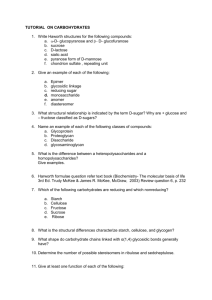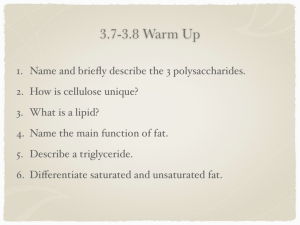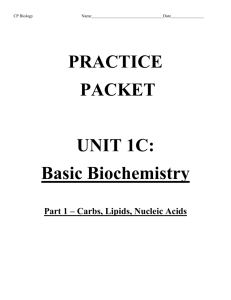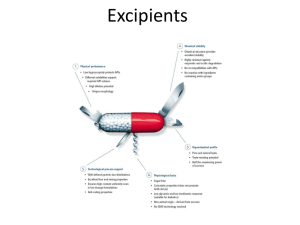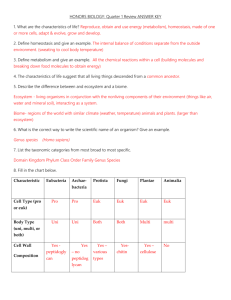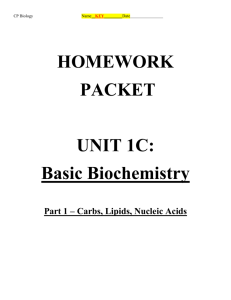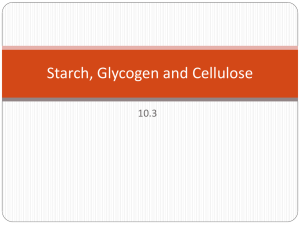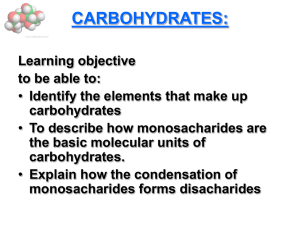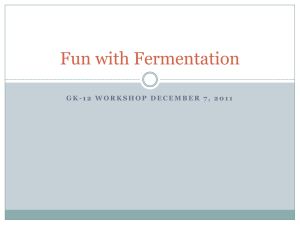Summary Questions_answers
advertisement
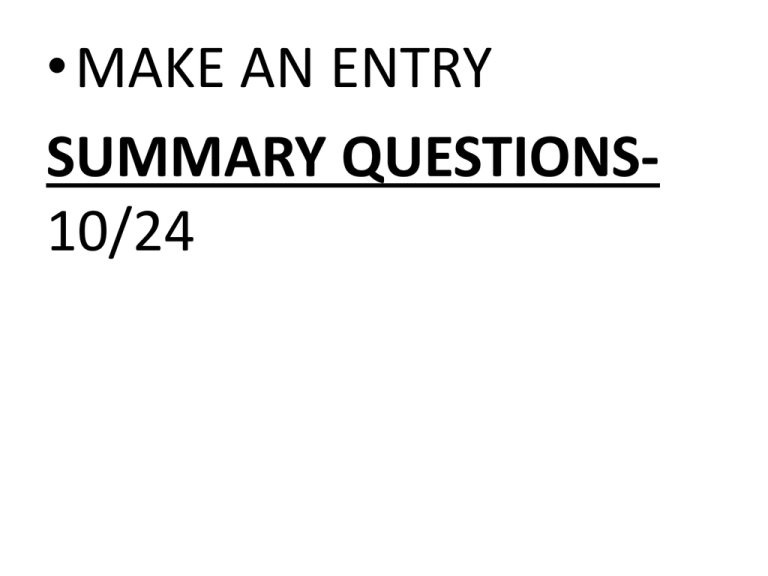
• MAKE AN ENTRY SUMMARY QUESTIONS10/24 1) Which time step best represents eating (ingestion)? Explain your reasoning. Time 0–food coming from outside the body to inside the body…but not broken yet 2) What building block is starch broken down into? Glucose What building blocks are fats broken down into? Fatty Acids and Glycerol What building blocks are proteins broken down into? Amino Acids 3) In what time step are most of the large molecules (carbohydrates, proteins, and fats) broken down into their building blocks/subunits? TIME 1-2 4) What happens to a protein in our digestive tract? Breaks down into amino acids 5) What typically happens to amino acids once they arrive in the cell? Rebuilt into proteins 6)What happens toBroken a fat molecule in our digestive tract? into fatty acids and glycerol 7) Compare and contrast glycogen, starch, and cellulose. • a. What do these molecules have in common? made of the subunit glucose • b. What is different between them? Cellulose has different bonds - not digested by humans Starch is stored in plants Glycogen is stored in animals Starch: a plant carbohydrate Glycogen: an animal carbohydrate 8) Some microorganisms that live outside our bodies can ‘digest’ cellulose. Into what subunits might these microorganisms be able to digest cellulose? glucose 9) Which time step (0-4) best represents the stages of growth Time 3-4 and storage? a. What new molecules are being assembled during these processes? Fats Proteins Glycogen RECAP What we should be solid on right now: 1- What food IS and IS NOT 2- Food molecules and their subunits 3- Chemical Energy = calories 4- How animals use food to grow • 10) Because fats and oils have 3 fatty acids attached to a glycerol molecule, they are also called triglycerides (tri means three). In the 1990s, when very low fat diets became popular, food manufacturers came out with new "nonfat" baked goods. To create these "non-fat" baked goods, they replaced the triglycerides with mono- and di-glycerides. People who ate a lot of these products found that they did not lose any weight. Explain why this was so. - Once the fatty acids and glycerol got to the cells- they were still reassembled by the cells into fats. 11) A potato has starch but no glycogen; muscle cells have glycogen but no starch. Explain how eating a potato could lead to increased glycogen in your muscle cells. - The starch we eat is broken into glucose in the stomach/small intest and then reassembled in the muscle cells as glycogen. 12) Using what you had for lunch yesterday, describe what happens to each of the major types of food molecules (carbohydrates, protein, and fats) as it makes its way from your mouth to the cells of your body. Be sure to include how the molecules in your chosen food item could eventually end up comprising the molecules that make up your body. (you can draw a picture to support your explanation too) This is just a practice question for your homework assignment. 13. Imagine you ate some fresh vegetables, lettuce or other types of raw plant material. – What type of carbohydrate would these foods likely contain? Starch, cellulose – What happens to this carbohydrate molecule during digestion? Starch broken into glucose, celluloseunbroken goes to large intestine – Where does this carbohydrate molecule go after digestion? Starch glucose glycogen in muscle cells celluloseunbroken goes to large intestinewaste 14. We are commonly told, “You are what you eat!” Discuss the accuracy of this statement based on what you have learned so far. How is this statement true? How is it untrue? Be VERY specific! - What you eat is broken down and reassembled. Some of it is reassembled into what you ate (fats, proteins) and some of it (starch) is reassembled into something else (glycogen) from the starch you ate. • Look back at your paper entitled “What is the Function of Food for Animals?” from the entry “FOOD FOR ANIMALS. Compare what you checked then and what you know now. How have your ideas changed? Explain. • This is simply for your own reflection. Please complete this question!

